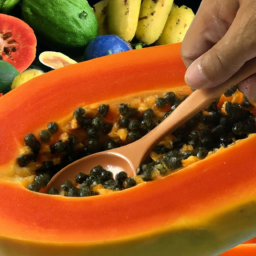As a huge fan of all things citrus, I always seem to reach for limes to give my dishes and beverages an extra burst of flavor. However, it can be tricky to figure out the right amount of limes to use in order to get a specific amount of juice, especially when recipes call for precise measurements.
That’s why I decided to do some research and find out exactly how many limes it takes to yield one cup of juice.
Picture this: you’re in the kitchen, ready to make a refreshing limeade or add some zest to your guacamole, but you’re not sure how many limes to juice. Do you need just one or two, or should you stock up on a whole bag? The answer depends on a few factors, including the size and juiciness of your limes, as well as your juicing technique.
In this article, we’ll explore the science behind lime juice yield, as well as some tips and tricks for getting the most juice out of your limes. So grab your citrus squeezer and let’s get started!
Key Takeaways
- Lime yield can vary based on lime variety, ripeness, acidity levels, and juicing technique.
- Generally, 8 medium-sized limes are needed to produce one cup of juice.
- Rolling limes before juicing can help maximize yield.
- Centrifugal juicers are fast but may not extract as much juice as masticating juicers, which are slower but provide higher yield and better nutrient retention.
Understanding Lime Juice Yield
To accurately determine how many limes are needed for 1 cup of juice, it’s important to understand the yield of lime juice per fruit. Lime varieties, such as Key limes and Persian limes, have different juice yields. Additionally, the ripeness of the lime can affect the amount of juice produced.
Another factor that can impact lime juice yield is acidity levels. Limes with higher acidity levels tend to produce more juice than those with lower acidity levels. When juicing limes, the method used can also affect the yield. For example, hand-squeezing a lime may produce less juice than using a juicer.
By understanding these factors, you can accurately determine how many limes are needed for 1 cup of juice.
Now, let’s dive into the specifics of how many limes are needed for one cup of juice.
How Many Limes for One Cup of Juice
You can easily extract enough citrusy liquid by squeezing a couple of fresh limes. But how many limes do you need to get one cup of lime juice? The answer lies in lime juice ratios. Generally, one medium-sized lime yields about 2 tablespoons of lime juice. Thus, it would take roughly 8 medium limes to produce one cup of lime juice.
However, the amount of juice you get from each lime may vary depending on the ripeness and size of the fruit. In addition, different juicing techniques may affect the yield. To ensure you get the most juice out of your limes, it is important to use fresh, ripe fruit and to use proper juicing techniques. Once you’ve extracted the juice, you can preserve it in the refrigerator for up to a week or freeze it for longer storage. Understanding lime juice ratios and preservation techniques can help you make the most out of your limes and ensure you always have fresh lime juice on hand.
Moving on to the next section, let’s explore some techniques for juicing limes.
Techniques for Juicing Limes
When it comes to juicing limes, there are a few techniques that I’ve found to be particularly effective. For a quick and easy option, I often opt for hand-squeezing.
However, if I need a larger quantity of juice, I find that using a juicer can save time and effort. To maximize juice yield, I also have a few tricks up my sleeve that I’ll share in this discussion.
Hand-Squeezing
Squeezing limes by hand can be a real pain in the neck, but it’s worth it to get that fresh, tangy flavor in your drinks. Here are some tips to improve your lime squeezing efficiency and get the most out of your fruit:
- Choose ripe limes – Limes that are fully ripe will yield more juice than unripe ones.
- Roll the limes – Before juicing, roll the limes on a hard surface with your palm to help break down the pulp and release more juice.
- Cut the limes in half crosswise – This will make it easier to grip the lime halves and squeeze out the juice.
- Use a citrus reamer – If you have one, use a citrus reamer to extract even more juice from the limes.
Using these best hand juicing techniques will help you get the most out of your limes and make your drinks taste even better.
But if you’re looking to save time and effort, using a juicer might be a better option.
Using a Juicer
If you’re craving for a quick and effortless way to extract the maximum amount of citrus flavor, using a juicer is the way to go. A juicer is a kitchen appliance that makes the juice extraction process much more efficient, as it separates the juice from the pulp.
However, it’s important to note that juicers need proper maintenance to ensure that they continue to perform well over time. After using a juicer, it’s essential to clean it thoroughly to prevent any leftover pulp or seeds from sticking to the blades or filter.
When it comes to selecting the best juicers for limes, there are several options available in the market. Some of the most popular ones include centrifugal juicers, which are fast and efficient but may not extract as much juice as other types. Masticating juicers, on the other hand, are slower but provide higher juice yield and better nutrient retention. Ultimately, the choice of juicer depends on personal preference and budget. Regardless of the type of juicer chosen, proper maintenance is key to ensuring its longevity and performance.
Now that we’ve explored the benefits of using a juicer and the best options available, let’s move on to maximizing the juice yield from our limes.
Maximizing Juice Yield
To get the most out of your lime, you’ll want to roll it firmly on a hard surface with the palm of your hand before cutting it open. This will help to break down the fibers inside the lime and release more juice.
Once you’ve rolled the lime, cut it in half and use a lime juicing tool to extract the juice. There are several different types of lime juicing tools available, including handheld juicers, electric juicers, and manual presses. Choose the tool that works best for you and your needs.
When it comes to maximizing juice yield, it’s important to remember the health benefits of lime juice. Lime juice is a great source of vitamin C, which can help to support immune function and reduce inflammation in the body. It also contains antioxidants that may help to protect against chronic diseases such as cancer and heart disease.
By taking the time to roll your limes and use the right juicing tool, you can ensure that you’re getting the most nutrient-rich juice possible.
Now, let’s move on to preparing limes for juicing.
Preparing Limes for Juicing
First, you’ll need to wash your limes thoroughly before cutting them for juicing. This is important because limes can harbor bacteria and dirt on their skin.
Once they are washed, you can begin preparing them for juicing. When selecting limes for juicing, it’s best to choose ones that are plump and heavy for their size. This is a good indication that they are ripe and will yield more juice.
Next, cut the limes in half and squeeze them with a citrus juicer or by hand. You can also roll the limes on a hard surface before cutting them to help release more juice. Be sure to remove any seeds that may fall into the juice.
By using these juicing techniques, you can maximize the amount of juice you get from each lime. Now that you have your freshly squeezed lime juice, let’s talk about how to store it for later use.
Storing Lime Juice
When storing lime juice, you’ll want to keep it in an airtight container in the refrigerator to maintain its freshness. This will prevent spoilage and maintain the juice’s quality for future use.
It’s best to use a glass container with a tight-fitting lid, as plastic containers can absorb the flavor and aroma of the lime juice and affect its taste.
You can also freeze lime juice to extend its shelf life. Simply pour the juice into an ice cube tray and freeze. Once the cubes are frozen, transfer them to a resealable freezer bag for long-term storage.
When you need lime juice, simply thaw the cubes in the refrigerator or at room temperature. With proper storage, lime juice can be kept fresh for up to 6 months in the freezer.
Now, let’s explore some other uses for limes beyond juicing.
Other Uses for Limes
Did you know that limes can be used for more than just making lime juice? Here are a few ways you can use limes to add a zesty flavor to your meals and drinks:
- Add lime zest to desserts like key lime pie or coconut lime bars for a refreshing twist.
- Mix lime juice into marinades for fish or chicken to add a tangy flavor.
- Use lime juice in cocktails like margaritas or mojitos for a bright, citrusy taste.
In addition to their delicious flavor, limes also have some health benefits. They’re a good source of vitamin C, which can help boost your immune system and fight off illness. Limes also contain antioxidants that can help protect your cells from damage.
Using limes in your recipes not only adds flavor but also provides some health benefits. In the next section, we’ll discuss how to incorporate lime juice into your dishes for a zesty kick.
Lime Juice in Recipes
While limes are undoubtedly a versatile fruit, their juicy and tangy flavor is often the highlight in many recipes. Lime juice is a common ingredient in a wide range of dishes, from salads and marinades to desserts and cocktails.
As someone who loves experimenting with different flavors in the kitchen, I always keep a bottle of lime juice on hand. Aside from adding a refreshing zing to your dishes, lime juice also offers a range of health benefits. It’s packed with vitamin C, which helps boost your immune system, and has been known to aid digestion and promote hydration.
When it comes to cocktails, lime juice is a crucial ingredient in a classic margarita or a refreshing mojito. Its bright, citrusy flavor perfectly balances out the sweetness of the alcohol, making for a well-rounded drink.
Overall, lime juice is a versatile ingredient that can add a burst of flavor to any recipe. As much as we love lime juice, sometimes we run out of it mid-recipe or simply don’t have any on hand. But don’t worry, there are plenty of substitutes that can work just as well, such as lemon juice or vinegar.
Let’s explore some of these alternatives in the next section.
Lime Juice Substitutes
Substituting lime juice in recipes is a great way to add new dimensions to your dishes and experiment with different flavors. There are several lime juice alternatives that can be used in place of fresh lime juice.
One popular substitute is bottled lime juice, which is readily available in most grocery stores. This option is convenient and has a longer shelf life than fresh lime juice, making it a great choice for those who don’t use lime juice often. However, bottled lime juice may not have the same fresh flavor as freshly squeezed lime juice.
Another alternative to fresh lime juice is lemon juice. Lemon juice has a similar tartness and acidity as lime juice and can be used in many of the same recipes. It’s also a great source of vitamin C, potassium, and other antioxidants, making it a healthy choice. However, lemon juice may not provide the same distinct flavor that lime juice does, so it’s important to consider the recipe and the desired taste when substituting it for lime juice.
When it comes to buying and choosing limes, there are a few things to keep in mind. Stay tuned for the next section where I’ll share tips for selecting the best limes for your recipes.
Buying and Choosing Limes
When I’m buying limes, I always consider their seasonal availability, whether they’re organic or conventional, and their freshness and quality.
Since limes are a tropical fruit, their availability may vary depending on the time of year and region.
I prefer to choose organic limes when possible, as they’re less likely to have been treated with harmful pesticides.
Additionally, I always try to select limes that are firm and heavy for their size, with smooth, shiny skin.
Seasonal Availability
You may have noticed that during the summer months, when the sun is shining and the weather is warm, limes are in abundance and readily available at your local grocery store. This is because limes are a seasonal fruit, and their peak growing season is from May to September.
During this time, limes are at their best in terms of flavor and quality, making them the perfect addition to any dish or drink. When it comes to choosing the best limes, it’s important to consider their ripeness. Limes that are too ripe will have a softer texture and may not be as tart, while limes that are not ripe enough will be harder and less juicy.
Some of the best lime varieties to look for include Persian limes, Key limes, and Kaffir limes. These varieties are known for their unique flavor profiles and are often used in a variety of cuisines around the world. Additionally, organic limes are a great option for those who are looking for a more environmentally friendly choice, as they are grown without the use of synthetic pesticides and fertilizers.
Transitioning into the subsequent section about ‘organic vs. conventional’, it’s important to consider the impact that our food choices have on the environment. While organic limes may be a more sustainable choice, they can also be more expensive than conventionally grown limes. It’s important to weigh the pros and cons of each option and make an informed decision based on your personal values and priorities.
Organic vs. Conventional
Now that we’ve discussed the seasonal availability of limes, let’s talk about the different types of farming methods used to grow them.
Organic farming is becoming increasingly popular due to its focus on sustainability and environmental impact. Organic farming practices prioritize the use of natural fertilizers and pesticides, as well as crop rotation and conservation of soil and water resources. This not only benefits the environment but also produces healthier and more nutrient-rich fruits.
On the other hand, conventional farming uses synthetic fertilizers and pesticides, which can have negative effects on the environment and potentially harm consumers. These chemicals can pollute nearby water sources and contribute to the decline of beneficial insects and wildlife.
While conventional farming may yield larger and more visually appealing fruits, they may not necessarily be as nutritious as their organic counterparts. Therefore, when it comes to selecting limes for juicing, choosing organic options may not only be better for the environment but also yield a better quality juice.
Moving forward to our next topic, let’s delve into how the freshness and quality of limes can impact the amount needed for one cup of juice.
Freshness and Quality
The flavor and nutritional value of your lime-based drinks can be greatly affected by the freshness and quality of the citrus fruit. Lime freshness is essential to achieve the best tasting lime juice.
When selecting limes, it’s important to choose ones that are firm to the touch, heavy for their size, and have a smooth skin. The fruit should also be free of any blemishes or soft spots. The longer limes sit on the shelf, the more their quality deteriorates, and the less juice they will yield.
Juice quality is affected by both the quality of the lime and the method used to extract the juice. Squeezing the lime by hand will result in a higher quality juice than using an electric juicer. This is because the electric juicer can damage the lime’s flesh and cause it to release more bitter compounds.
It’s also important to use the juice immediately after extracting it for the best flavor and nutritional value. Lime juice can quickly lose its quality, and the longer it sits, the more it will oxidize and lose its flavor.
By choosing fresh, high-quality limes and using them immediately after extraction, you can ensure that your lime-based drinks are bursting with flavor and nutrition.
Frequently Asked Questions
How long do limes typically last before going bad?
Limes have a shelf life of up to 4 weeks when stored in the refrigerator. To extend their life, wrap them in a paper towel and place them in a plastic bag. Avoid storing them near ethylene-producing fruits like apples or bananas.
Are there any health benefits to drinking lime juice?
Drinking lime juice has numerous health benefits. It is a great source of vitamin C, antioxidants, and can aid in digestion and weight loss. Lime juice benefits also include improving skin and hair health and reducing the risk of chronic diseases.
Can lime juice be frozen for later use?
Freezing lime juice is a great way to preserve its flavor and freshness for later use. However, it’s important to note that the quality may degrade over time. A metaphor that comes to mind is that freezing lime juice is like pausing a song – it may not be the same when you hit play again.
How do I properly clean and sanitize my juicer before and after use?
To properly maintain my juicer, I use a combination of cleaning techniques. First, I disassemble the juicer and clean all removable parts with warm, soapy water. Then, I sanitize with a mixture of water and vinegar or bleach solution. Finally, I dry all parts thoroughly before reassembling.
Are there any alternative tools or methods for juicing limes besides using a juicer?
When it comes to lime squeezing techniques, there are alternatives to using a juicer. Hand juicing is a simple and effective method, while mechanical juicing may be faster for larger quantities. Both methods can yield high-quality juice.
Conclusion
In conclusion, knowing how many limes to use for one cup of juice is essential for any recipe that calls for this citrus fruit. Understanding lime juice yield is crucial to making sure you have the right amount of juice for your dish. Techniques for juicing limes can vary, but taking the time to prepare the limes properly can make a big difference in the amount of juice you get.
Additionally, storing lime juice correctly and knowing other uses for limes can help you make the most out of this versatile fruit. Whether you’re using lime juice in recipes or looking for a substitute, it’s important to choose the right limes and understand their properties.
Armed with this knowledge, you can confidently add lime juice to your favorite dishes and enjoy the zesty, refreshing flavor it brings.
Ilana has been a vegan for over 10 years. She originally made the switch for health reasons, but soon found herself becoming more and more passionate about the ethical and environmental implications of a vegan lifestyle. Ilana is the author of The Graceful Kitchen, a blog all about veganism. She loves to cook up delicious and nutritious vegan meals, and share her recipes with others who are interested in leading a cruelty-free life. Ilana is also a strong advocate for using whole foods as the foundation of a healthy diet, and believes that going vegan is one of the best ways to achieve this.










